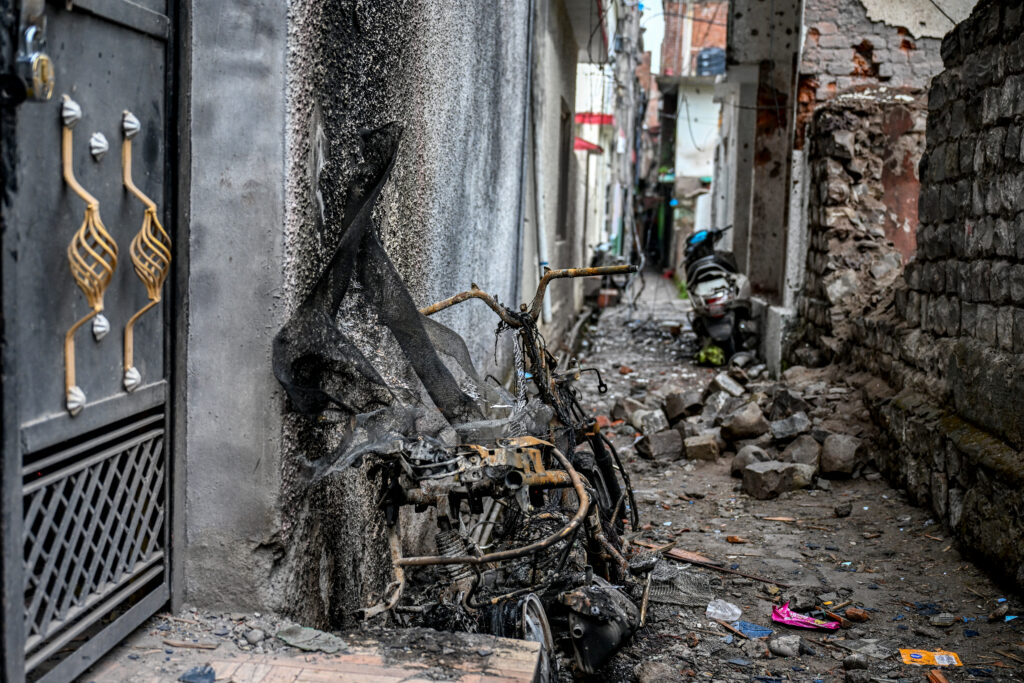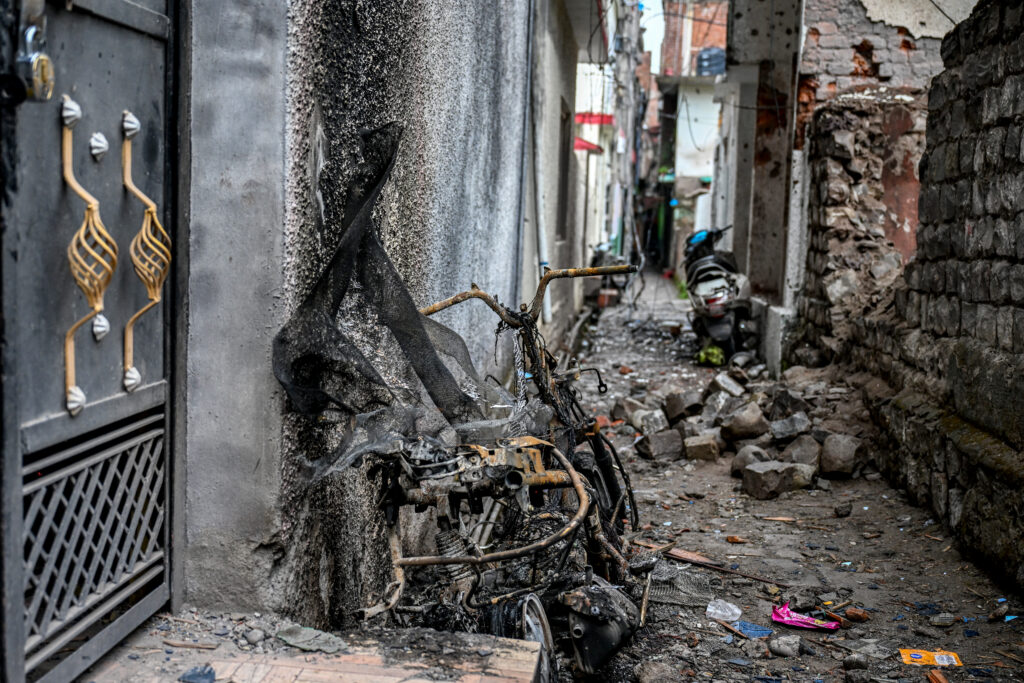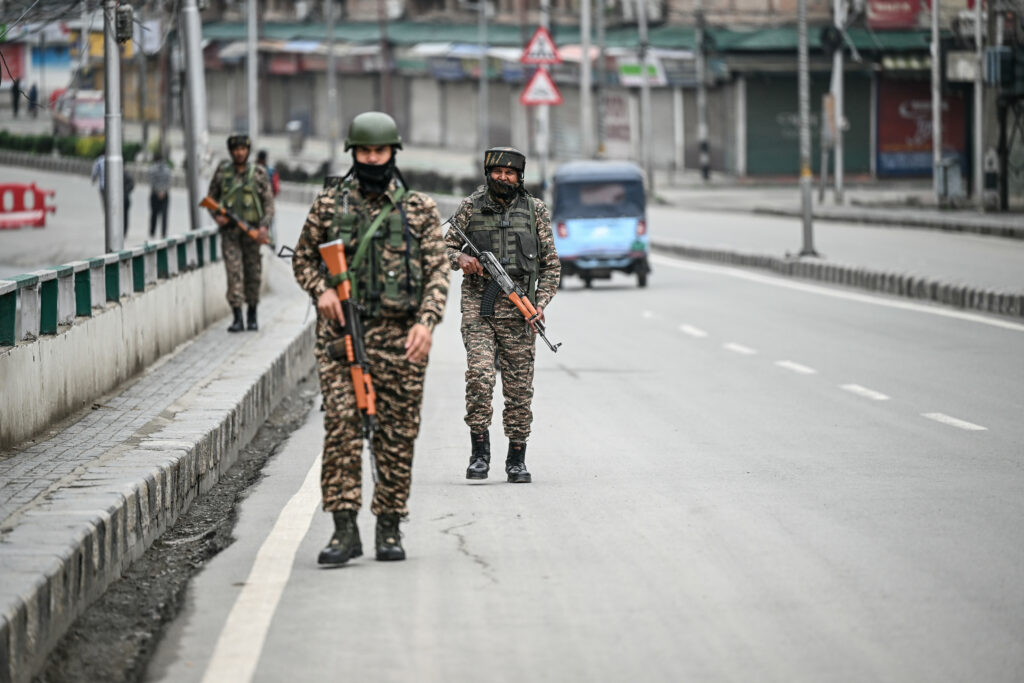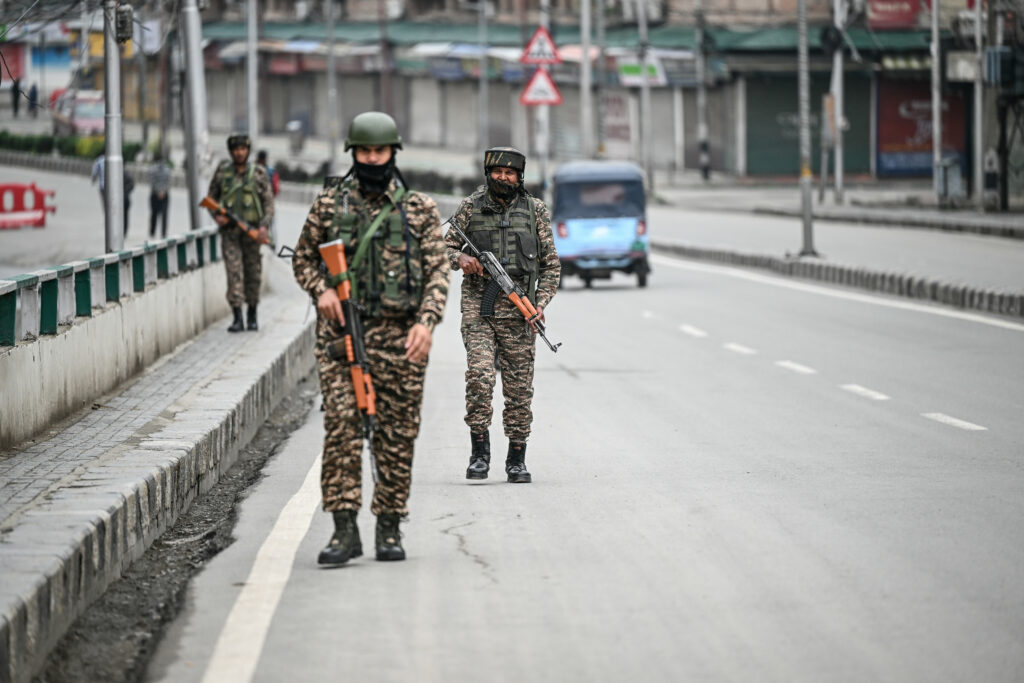En Inde, Poonch pleure la mort de ses jumeaux sous les obus pakistanais
Zian Khan, 12 ans, et sa jumelle Urwa Fatima ont été tués par un obus pakistanais. Pour tous les habitants de la ville indienne de Poonch (nord-ouest), ils sont le visage de la guerre qui a changé à jamais le cours de leurs vies. Le frère et la sœur ont été fauchés mercredi matin tout près de leur maison, alors que l’artillerie du Pakistan ripostait aux frappes ordonnées par l’Inde après l’attentat meurtrier de Pahalgam.Leur mère, Urusa Khan, 30 ans, n’a été que légèrement blessée par les éclats. Leur père, Rameez Khan, 46 ans, a été grièvement touché et hospitalisé entre la vie et la mort.Ce matin-là, c’est un déluge de feu qui a plu sur Poonch, le long de la “ligne de contrôle” qui sépare le Cachemire entre les deux pays.Le bilan est lourd, très lourd. Au moins 12 morts, 49 blessés et des dizaines de maisons éventrées.Jusqu’au cessez-le-feu immédiat signé samedi, les bombardements n’ont pas cessé. La nuit, le jour, entrecoupés de quelques heures de répit. La plupart de ses 60.000 habitants en ont profité pour fuir vers l’arrière.Cousin des jumeaux, Sarfaraz Mir, 40 ans, n’a pas rejoint cet exode. Il fait partie des quelques milliers restés dans les ruines de la ville-fantôme.”Aucun d’entre nous n’avait jamais imaginé que notre ville ou une autre zone civile puisse un jour être prise pour cible comme ça”, confie-t-il. “Mais il semble que notre ville a été visée délibérément. Les gens ont encore très peur…”Sarfaraz Mir décrit avec précision les instants qui ont précédé la mort des deux adolescents.La famille venait juste de franchir le seuil de la maison, tout près de l’école d’Urwa et Zian, pour échapper aux obus. Leur mère a alors brusquement fait demi-tour pour prendre à l’intérieur quelque chose qu’elle avait oublié.”A cet instant précis, un obus a explosé juste à côté de leur logement”, se souvient le cousin. Urwa est morte instantanément, son frère peu après.- “Un choc impensable” -“Les gens ne se sont occupés du père que plus tard”, poursuit Sarfaraz. “Il avait perdu beaucoup de sang, il est toujours dans un état critique”.Avec la mort des deux enfants est venu pour la famille le temps du regret. Celui d’avoir quitté le village de Chaktroo où elle habitait pour emménager près de leur école.”Leur mort a été un choc impensable”, soupire Fiaz Diwan, 30 ans, un proche.”Ils seraient encore en vie si leurs parents n’avaient pas voulu leur donner la meilleure éducation et le meilleur avenir”, continue-t-il, “je ne peux m’empêcher de penser à leur détresse”.De nombreux habitants la partagent, eux aussi touchés dans leur chair par la brutale vague de violence qui s’est abattue sur la ville.Poonch “est un bouquet de communautés – Hindous, Sikhs, Musulmans – qui vivent harmonieusement ensemble”, souligne Sarfaraz Mir. “On dirait qu’ils (les Pakistanais) ont voulu s’en prendre à ça”, regrette-t-il.Un temple sikh et un autre hindou ont été endommagés par les bombardements.Le secrétaire du ministère indien des Affaires extérieures, Vikram Misri, a publiquement accusé l’armée pakistanaise d’avoir frappé ces lieux de culte “dans un but précis”. “Le Pakistan n’était jamais tombé aussi bas”, a-t-il lâché.New Delhi a accusé Islamabad de soutenir le groupe jihadiste qu’il soupçonne d’avoir assassiné 26 civils le 22 avril dernier. Le Pakistan a démenti fermement toute implication dans l’attaque.Depuis la mort de Zian et Urwa, leur cousin reste inconsolable. Seul le courage de leur mère lui a redonné un peu d’espoir.Sitôt ses deux enfants enterrés, elle est retournée à l’hôpital au chevet de son mari, qui ignore toujours leur mort. “Dieu lui a donné des nerfs d’acier pour traverser tout ça avec autant de calme et de dignité”, salue Sarfaraz Mir.
En Inde, Poonch pleure la mort de ses jumeaux sous les obus pakistanais
Zian Khan, 12 ans, et sa jumelle Urwa Fatima ont été tués par un obus pakistanais. Pour tous les habitants de la ville indienne de Poonch (nord-ouest), ils sont le visage de la guerre qui a changé à jamais le cours de leurs vies. Le frère et la sœur ont été fauchés mercredi matin tout près de leur maison, alors que l’artillerie du Pakistan ripostait aux frappes ordonnées par l’Inde après l’attentat meurtrier de Pahalgam.Leur mère, Urusa Khan, 30 ans, n’a été que légèrement blessée par les éclats. Leur père, Rameez Khan, 46 ans, a été grièvement touché et hospitalisé entre la vie et la mort.Ce matin-là, c’est un déluge de feu qui a plu sur Poonch, le long de la “ligne de contrôle” qui sépare le Cachemire entre les deux pays.Le bilan est lourd, très lourd. Au moins 12 morts, 49 blessés et des dizaines de maisons éventrées.Jusqu’au cessez-le-feu immédiat signé samedi, les bombardements n’ont pas cessé. La nuit, le jour, entrecoupés de quelques heures de répit. La plupart de ses 60.000 habitants en ont profité pour fuir vers l’arrière.Cousin des jumeaux, Sarfaraz Mir, 40 ans, n’a pas rejoint cet exode. Il fait partie des quelques milliers restés dans les ruines de la ville-fantôme.”Aucun d’entre nous n’avait jamais imaginé que notre ville ou une autre zone civile puisse un jour être prise pour cible comme ça”, confie-t-il. “Mais il semble que notre ville a été visée délibérément. Les gens ont encore très peur…”Sarfaraz Mir décrit avec précision les instants qui ont précédé la mort des deux adolescents.La famille venait juste de franchir le seuil de la maison, tout près de l’école d’Urwa et Zian, pour échapper aux obus. Leur mère a alors brusquement fait demi-tour pour prendre à l’intérieur quelque chose qu’elle avait oublié.”A cet instant précis, un obus a explosé juste à côté de leur logement”, se souvient le cousin. Urwa est morte instantanément, son frère peu après.- “Un choc impensable” -“Les gens ne se sont occupés du père que plus tard”, poursuit Sarfaraz. “Il avait perdu beaucoup de sang, il est toujours dans un état critique”.Avec la mort des deux enfants est venu pour la famille le temps du regret. Celui d’avoir quitté le village de Chaktroo où elle habitait pour emménager près de leur école.”Leur mort a été un choc impensable”, soupire Fiaz Diwan, 30 ans, un proche.”Ils seraient encore en vie si leurs parents n’avaient pas voulu leur donner la meilleure éducation et le meilleur avenir”, continue-t-il, “je ne peux m’empêcher de penser à leur détresse”.De nombreux habitants la partagent, eux aussi touchés dans leur chair par la brutale vague de violence qui s’est abattue sur la ville.Poonch “est un bouquet de communautés – Hindous, Sikhs, Musulmans – qui vivent harmonieusement ensemble”, souligne Sarfaraz Mir. “On dirait qu’ils (les Pakistanais) ont voulu s’en prendre à ça”, regrette-t-il.Un temple sikh et un autre hindou ont été endommagés par les bombardements.Le secrétaire du ministère indien des Affaires extérieures, Vikram Misri, a publiquement accusé l’armée pakistanaise d’avoir frappé ces lieux de culte “dans un but précis”. “Le Pakistan n’était jamais tombé aussi bas”, a-t-il lâché.New Delhi a accusé Islamabad de soutenir le groupe jihadiste qu’il soupçonne d’avoir assassiné 26 civils le 22 avril dernier. Le Pakistan a démenti fermement toute implication dans l’attaque.Depuis la mort de Zian et Urwa, leur cousin reste inconsolable. Seul le courage de leur mère lui a redonné un peu d’espoir.Sitôt ses deux enfants enterrés, elle est retournée à l’hôpital au chevet de son mari, qui ignore toujours leur mort. “Dieu lui a donné des nerfs d’acier pour traverser tout ça avec autant de calme et de dignité”, salue Sarfaraz Mir.
“Cessez-le-feu immédiat” entre l’Inde et le Pakistan, annonce Trump
Après plusieurs jours d’attaques meurtrières de drones, de tirs d’artillerie et de frappes de missiles, le Pakistan et l’Inde ont accepté samedi un “cessez-le-feu immédiat”, a annoncé à la surprise générale le président américain Donald Trump, saluant le “bon sens” des deux puissances nucléaires.Depuis mercredi, les deux voisins, nés d’une douloureuse partition en 1947 au départ du colonisateur britannique, étaient sourds aux appels à la retenue des capitales étrangères qui redoutaient le point de non-retour.”Après une longue nuit de discussions sous la médiation américaine, je suis heureux d’annoncer que l’Inde et le Pakistan ont accepté un CESSEZ-LE-FEU TOTAL ET IMMEDIAT”, a écrit Donald Trump sur son réseau Truth Social, adressant ses “félicitations aux deux pays” pour leur “bon sens et grande intelligence”.Dans la foulée à Islamabad, le ministre pakistanais des Affaires étrangères Ishaq Dar a confirmé que le Pakistan et l’Inde avaient accepté “un cessez-le-feu avec effet immédiat” dans un message sur X.Confirmant aussi un accord de cessez-le-feu, à Delhi, une source gouvernementale indienne indiquait toutefois qu’il avait été directement négocié entre l’Inde et le Pakistan et que les deux pays voisins n’avaient pas prévu de discuter d’autre chose que du cessez-le-feu.Le secrétaire d’État américain Marco Rubio venait de déclarer sur X que l’accord faisait suite à des négociations approfondies entre lui-même et le vice-président JD Vance avec les Premiers ministres indiens et pakistanais Narendra Modi et Shehbaz Sharif, ainsi que d’autres hauts responsables.”Je suis heureux d’annoncer que les gouvernements de l’Inde et du Pakistan ont accepté un cessez-le-feu immédiat et de commencer des pourparlers sur un large éventail de questions dans un lieu neutre”, a aussi déclaré M. Rubio. – “Vengé les morts innocents ” -Tout avait commencé le 22 avril avec un attentat qui a choqué l’Inde: des hommes armés ont abattu 26 hommes sur un site touristique au Cachemire indien. New Delhi a accusé Islamabad de soutenir le groupe jihadiste qu’elle soupçonne de l’attaque, ce que son voisin a démentu fermement.Après des sanctions diplomatiques, des menaces sur le partage des eaux du fleuve Indus, les deux pays sont entrés mercredi dans leur pire confrontation militaire depuis des décennies.Ce jour-là, l’Inde a mené des frappes sur plusieurs villes pakistanaises assurant y détruire des “camps terroristes” et entraînant une spirale d’attaques et de contre-attaques. Samedi matin encore, le Pakistan annonçait lancer sa riposte après des tirs de missiles indiens sur des bases militaires, dont l’une aux portes d’Islamabad.Le Premier ministre pakistanais affirmait qu'”avec l’opération ‘Edifice compact'”, le Pakistan avait “donné à l’Inde une réponse adéquate et vengé les morts innocents” –une “vengeance” qu’il avait promise dans une adresse à la nation mercredi.L’Inde a confirmé avoir subi une série d’attaques, notamment de drones, contre plusieurs cibles militaires situées dans toute la partie nord-ouest de son territoire.La principale ville du Cachemire indien, Srinagar, a été plusieurs fois secouée samedi par de violentes détonations, ont constaté des journalistes de l’AFP.Touchée au petit matin, la base aérienne d’Awantipora, près de Srinagar, a encore été frappée à la mi-journée, selon une source policière s’exprimant sous couvert de l’anonymat.Marco Rubio avait alors exhorté ses homologues indien et pakistanais “à rétablir une communication directe pour éviter toute erreur de calcul”, tandis que la Chine haussait le ton, en appelant “fermement” les deux voisins à la retenue.- “Dégâts limités” -Selon le bilan officiel des deux camps, les violences ont tué une soixantaine de civils depuis mercredi.Cet état de guerre a suscité d’importants mouvements de population de part et d’autre de la “ligne de contrôle” qui sépare la région contestée du Cachemire entre les deux pays. Dans la partie indienne, la gare de la ville de Jammu, visée par des attaques de drones pakistanais les deux dernières nuits, était prise d’assaut samedi par des habitants en quête d’un train.”Il y a eu des fortes explosions toute la nuit”, a confié à l’AFP sur un quai l’un des candidats au départ, Karan Varma, un maçon de 41 ans. “Il n’y a pas d’autre choix que de partir”.De l’autre côté de la frontière de facto, Mohammed Hussain a raconté à l’AFP une nuit de violence qui a tué, selon les autorités du Cachemire pakistanais, 11 civils.”Ma maison a été fortement endommagée dans les tirs, j’essaie d’évacuer ma famille vers un endroit plus sûr”, a-t-il dit.Après l’annonce du cessez-le-feu, le Pakistan a rouvert son espace aérien alors que côté indien, 32 aéroports du quart nord-ouest du pays restaient fermés.burs-pa-sbh/pt
“Cessez-le-feu immédiat” entre l’Inde et le Pakistan, annonce Trump
Après plusieurs jours d’attaques meurtrières de drones, de tirs d’artillerie et de frappes de missiles, le Pakistan et l’Inde ont accepté samedi un “cessez-le-feu immédiat”, a annoncé à la surprise générale le président américain Donald Trump, saluant le “bon sens” des deux puissances nucléaires.Depuis mercredi, les deux voisins, nés d’une douloureuse partition en 1947 au départ du colonisateur britannique, étaient sourds aux appels à la retenue des capitales étrangères qui redoutaient le point de non-retour.”Après une longue nuit de discussions sous la médiation américaine, je suis heureux d’annoncer que l’Inde et le Pakistan ont accepté un CESSEZ-LE-FEU TOTAL ET IMMEDIAT”, a écrit Donald Trump sur son réseau Truth Social, adressant ses “félicitations aux deux pays” pour leur “bon sens et grande intelligence”.Dans la foulée à Islamabad, le ministre pakistanais des Affaires étrangères Ishaq Dar a confirmé que le Pakistan et l’Inde avaient accepté “un cessez-le-feu avec effet immédiat” dans un message sur X.Confirmant aussi un accord de cessez-le-feu, à Delhi, une source gouvernementale indienne indiquait toutefois qu’il avait été directement négocié entre l’Inde et le Pakistan et que les deux pays voisins n’avaient pas prévu de discuter d’autre chose que du cessez-le-feu.Le secrétaire d’État américain Marco Rubio venait de déclarer sur X que l’accord faisait suite à des négociations approfondies entre lui-même et le vice-président JD Vance avec les Premiers ministres indiens et pakistanais Narendra Modi et Shehbaz Sharif, ainsi que d’autres hauts responsables.”Je suis heureux d’annoncer que les gouvernements de l’Inde et du Pakistan ont accepté un cessez-le-feu immédiat et de commencer des pourparlers sur un large éventail de questions dans un lieu neutre”, a aussi déclaré M. Rubio. – “Vengé les morts innocents ” -Tout avait commencé le 22 avril avec un attentat qui a choqué l’Inde: des hommes armés ont abattu 26 hommes sur un site touristique au Cachemire indien. New Delhi a accusé Islamabad de soutenir le groupe jihadiste qu’elle soupçonne de l’attaque, ce que son voisin a démentu fermement.Après des sanctions diplomatiques, des menaces sur le partage des eaux du fleuve Indus, les deux pays sont entrés mercredi dans leur pire confrontation militaire depuis des décennies.Ce jour-là, l’Inde a mené des frappes sur plusieurs villes pakistanaises assurant y détruire des “camps terroristes” et entraînant une spirale d’attaques et de contre-attaques. Samedi matin encore, le Pakistan annonçait lancer sa riposte après des tirs de missiles indiens sur des bases militaires, dont l’une aux portes d’Islamabad.Le Premier ministre pakistanais affirmait qu'”avec l’opération ‘Edifice compact'”, le Pakistan avait “donné à l’Inde une réponse adéquate et vengé les morts innocents” –une “vengeance” qu’il avait promise dans une adresse à la nation mercredi.L’Inde a confirmé avoir subi une série d’attaques, notamment de drones, contre plusieurs cibles militaires situées dans toute la partie nord-ouest de son territoire.La principale ville du Cachemire indien, Srinagar, a été plusieurs fois secouée samedi par de violentes détonations, ont constaté des journalistes de l’AFP.Touchée au petit matin, la base aérienne d’Awantipora, près de Srinagar, a encore été frappée à la mi-journée, selon une source policière s’exprimant sous couvert de l’anonymat.Marco Rubio avait alors exhorté ses homologues indien et pakistanais “à rétablir une communication directe pour éviter toute erreur de calcul”, tandis que la Chine haussait le ton, en appelant “fermement” les deux voisins à la retenue.- “Dégâts limités” -Selon le bilan officiel des deux camps, les violences ont tué une soixantaine de civils depuis mercredi.Cet état de guerre a suscité d’importants mouvements de population de part et d’autre de la “ligne de contrôle” qui sépare la région contestée du Cachemire entre les deux pays. Dans la partie indienne, la gare de la ville de Jammu, visée par des attaques de drones pakistanais les deux dernières nuits, était prise d’assaut samedi par des habitants en quête d’un train.”Il y a eu des fortes explosions toute la nuit”, a confié à l’AFP sur un quai l’un des candidats au départ, Karan Varma, un maçon de 41 ans. “Il n’y a pas d’autre choix que de partir”.De l’autre côté de la frontière de facto, Mohammed Hussain a raconté à l’AFP une nuit de violence qui a tué, selon les autorités du Cachemire pakistanais, 11 civils.”Ma maison a été fortement endommagée dans les tirs, j’essaie d’évacuer ma famille vers un endroit plus sûr”, a-t-il dit.Après l’annonce du cessez-le-feu, le Pakistan a rouvert son espace aérien alors que côté indien, 32 aéroports du quart nord-ouest du pays restaient fermés.burs-pa-sbh/pt
Lot: “Autour de 10.000 participants” à une rave-party illégale
Une rave-party illégale organisée dans le Lot réunissait samedi “autour de 10.000 participants”, en légère augmentation par rapport aux 9.000 de vendredi, selon la préfecture, qui faisait état de l’évacuation sanitaire d’une personne pour consommation de stupéfiants.”Nous avons autour de 10.000 participants sur site actuellement, nous contrôlons l’ensemble des accès routiers, nous assurons sur l’ensemble de ces points les contrôles nécessaires et toutes les infractions sont relevées”, a expliqué la préfète du Lot, Claire Raulin, lors d’un point-presse.”Sur le plan sanitaire, nous avons évacué une personne qui avait consommé des stupéfiants vers l’hôpital le plus proche, elle est actuellement en observation”, a précisé Mme Raulin, ajoutant que “80 personnes ont été prises en charge par les personnels de la sécurité civile pour des petites traumatologies”.Au total, environ 200 personnes de services de l’Etat et des secours sont présents sur place, dont une “vingtaine de secouristes”, a-t-elle précisé.L’évènement qui a débuté dans la nuit de mercredi à jeudi devrait se poursuivre jusqu’à dimanche soir et occasionne “des nuisances très nombreuses”, selon la préfète qui fera “un bilan du nombre de contrôles et des infractions relevées à la fin de l’évènement”.”C’est bien de faire la fête mais il faut aussi penser aux conséquences”, a affirmé lors du point de presse, Guilhem Cledel, le maire de Montvalent, l’une des deux communes, avec Rocamadour, sur le terrain desquelles est organisée la fête techno.”Mes administrés n’en peuvent plus, ils sont excédés, fatigués et inquiets, il y a quand même énormément d’angoisse”, a-t-il dit.
Un pompier renversé par une voiture lors d’un rodéo urbain en Haute-Savoie
Un sapeur-pompier volontaire se trouve entre la vie et la mort samedi après avoir été percuté “délibérément” par un automobiliste qui effectuait des rodéos près de sa caserne à Evian-les-Bains (Haute-Savoie).Le ministre de l’Intérieur Bruno Retailleau et le ministre attaché à l’Intérieur François-Noël Buffet se rendront sur les lieux en fin d’après-midi, selon leurs services.”Ce matin à Evian un pompier volontaire a été délibérément percuté lors d’un rodéo urbain, il lutte pour la vie”, a écrit le second sur X, en annonçant leur déplacement.La victime, âgée de 38 ans, a été renversée par une voiture qui effectuait des rodéos à proximité de sa caserne, a indiqué à l’AFP une source proche des pompiers.L’auteur “a d’ores-et-déjà été interpellé par les policiers de la circonscription de police nationale de Thonon-les Bains”, a ajouté la préfecture de Haute-Savoie, sans donner plus de détails sur les circonstances des faits, ni de l’interpellation.Sollicité par l’AFP, le parquet n’a pas répondu dans l’immédiat. Selon Martial Saddier, président du Département de la Haute-Savoie, le pompier blessé “a été héliporté ce matin de bonne heure à l’hôpital d’Annecy” dans un état critique. “L’enquête le déterminera, mais il semblerait bien qu’il y ait eu une volonté de percuter un pompier”, a-t-il dit sur BFM TV.- “Fléau” -“Total soutien au sapeur-pompier de la caserne de Evians-les-Bains très gravement percuté par un conducteur effectuant un rodéo devant la caserne”, a réagi sur le réseau X le président de la Fédération nationale des Sapeurs-pompiers de France, Jean-Paul Bosland. “Tolérance 0 pour ces individus manquant de discernement et irrespectueux de la sécurité publique et de l’ordre public”, ajoute-t-il.Bruno Retailleau et François-Noël Buffet sont attendus sur place vers 18H00, ont précisé leurs services.La veille, le ministre de la Justice Gérald Darmanin a appelé à “la plus grande fermeté contre le fléau des rodéos urbains, qui pourrit la vie de nombreux Français”. Les procureurs de la République “devront désormais saisir systématiquement les véhicules impliqués dans des rodéos et, comme la loi le permet, les vendre ou les faire détruire avant même le jugement. Stop à l’impunité !”, a-t-il écrit sur X.Il y a deux ans, il avait déjà conseillé aux préfets d’autoriser l’usage de drones pour lutter contre les rodéos urbains, qui consistent à réaliser des manoeuvres dangereuses avec des engins motorisés (acrobaties, zigzag etc) en violation du code de la route, et parfois en groupe.Un rodéo urbain rassemblant 500 voitures et près de 3.000 personnes s’est tenu vendredi soir à Bordeaux, avant d’être stoppé et dispersé par une intervention des forces de l’ordre, a-t-on appris samedi auprès de la police.Il y a une semaine, un élu municipal de Gironde a été agressé après avoir tenté de mettre fin à un rodéo de motards. Il souffre de plusieurs fractures au visage. La Haute-Savoie a également été endeuillée lors d’un conflit entre deux groupes d’automobilistes à Gaillard dans la nuit de vendredi à samedi. Un homme de 23 ans, sorti de sa voiture pour en découdre, a été percuté par la voiture de l’autre groupe puis écrasé contre un muret. Il est décédé. Deux passagers de cette même voiture ont pour été blessés, dont l’un avec un pronostic vital engagé, selon une source policière. Le conducteur a été interpellé et placé en garde à vue.






